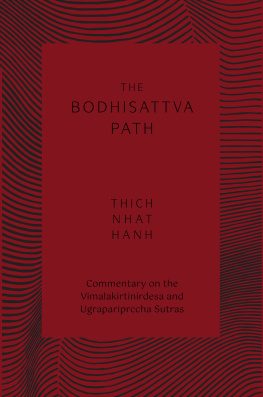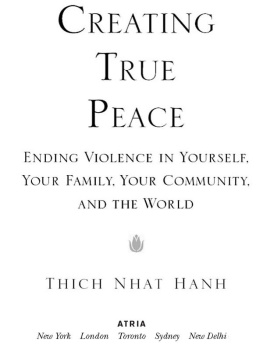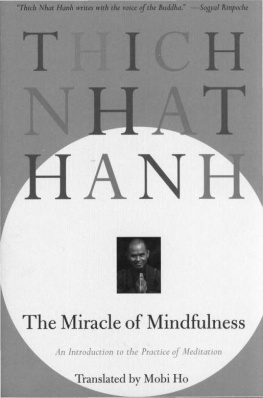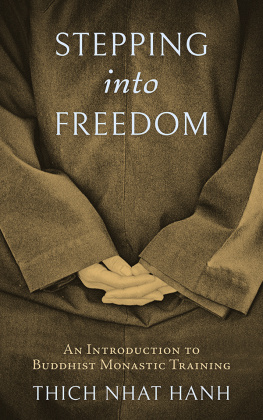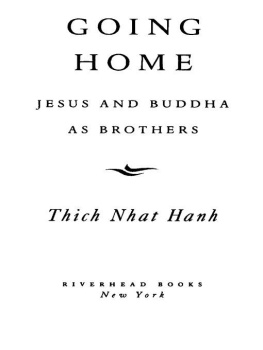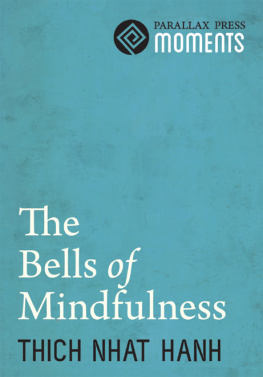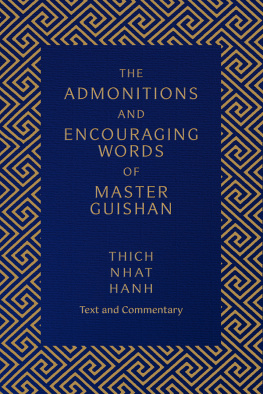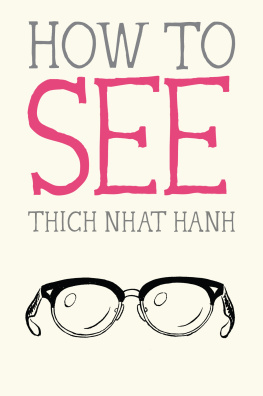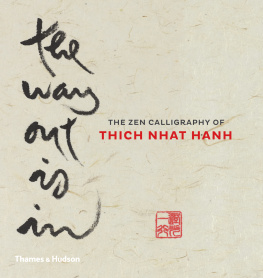
Published by Palm Leaves Press
an imprint of Parallax Press
Parallax Press
2236B Sixth Street
Berkeley, California 94710
parallax.org
Copyright 2022 by
Plum Village Community of
Engaged Buddhism, Inc.
All rights reserved
Printed in Canada
Originally published in Vietnamese as
B Tt Ti Gia, B Tt Xut Gia
by L Bi, San Jose, CA, 2002.
Cover design by Katie Eberle
Text design and composition by Maureen Forys
Printed on Enviro Book Natural
ISBN: 978-1-952692-33-8
E-book ISBN: 978-1-952692-34-5
Non-English words are in Sanskrit unless otherwise indicated or made clear by the context.
Library of Congress Control Number: 2022943251
Translators Introduction
This book is compiled from Dharma talks given in Vietnamese by the Venerable Thch Nht Hnh on the Mahyna sutras between November 10, 1991 and December 8, 1991, during the Winter Retreat in Plum Village, France.
If we analyze the word bodhisattva we see that bodhi means awakening, enlightenment, or deep understanding, and sattva means a living being. A bodhisattva is a being who enlightens others and enlightens themself. Enlightening oneself and enlightening others go together. This is something many of us have a deep aspiration to do. Understanding also means love. Once there is understanding there has to be love, and without understanding there cannot be true love.
This book contains the commentaries of the Venerable Thich Nhat Hanh on two early Mahyna sutras about what it means to be a bodhisattva. You can be a monastic bodhisattva or a lay bodhisattva, but these sutras stress the importance of being a lay bodhisattva. At the time they were written, the lay practice was often looked on as inferior to the monastic practice. These sutras are a manifesto for the effectiveness and significance of lay Buddhist practice.
The first sutra, the Ugraparipccha, Questions of the Householder Ugra, is a comparatively gentle opening up of the way of esteeming a lay bodhisattva. It keeps respect for the value of the monastic path. The lay bodhisattva is even seen to model themself on the monastic bodhisattva. This sutra is a very solid, down-to-earth teaching. It encourages tolerance in the bodhisattva, whose role is not to judge those who do not practice but to help by example.
The second sutra, the Vimalakrtinirdea is more iconoclastic. It does not spare even the most revered monastics of the time of the Buddha kyamuni. Nevertheless it has a very important message: that a bodhisattva must be engaged in helping the world and is not seeking personal enlightenment.
The Ugraparipccha is easy enough to follow because it remains firmly in the historical dimension. The Vimalakrtinirdea tends to hop between the ultimate and the historical dimensions. On the one hand it praises nondiscrimination and on the other it discriminates between the Greater Vehicle (the Mahayana) and the rvaka and Pratyekabuddha Vehicles.
One of the important aspects of the commentary by the Venerable Thich Nhat Hanh is that it helps us to see when the sutra is concerned with the historical dimension and when it is concerned with the ultimate dimension.
Although the Venerable Thich Nhat Hanh often suggests that we read the sutra itself rather than the commentaries on it, I have been very grateful to have been able to read this particular commentary, albeit with its lengthy citations from the sutras, before attempting to read the sutras themselves. The Mahyna sutras often can be a great ocean which we need a pilot to help us navigate.
In this book the citations of the sutras have been carefully chosen by the author to help us understand the essence of the sutras. Therefore the book becomes a guide on the path of training to become an authentic bodhisattva.
We do not want to become a store of knowledge about the sutras that we are not able to put into practice. The Venerable Thich Nhat Hanh is an engaged bodhisattva and has much valuable experience in the way of engaging the practice in the world. His experience helps us put these teachings into practice.
In my personal practice these sutras have been a great source of inspiration, especially in the teachings to treat adverse circumstances as opportunities rather than obstacles. Particularly interesting is the discussion of ill-health: how to practice with it and how to look deeply into it. Being a bodhisattva is not to run away from ill-health.
As the Venerable Thich Nhat Hanh remarks, reading the Vimalakrtinirdea is like reading a play. Colorful and dramatic scenes reflect the culture of India of that time.
As I finished translating this book I wrote the following lines:
A living being,
a breathing being,
earth, water,
fire, air,
space and consciousness.
Evolving, dissolving,
for the good of the world,
for the good of all.
We face a crisis now that Vimalakrti and Ugra did not face. We do not know whether the human species or life on Earth can survive it. Still, in every moment that we have left to us, we can carry on the career of an awakening being and offer up the merit for the alleviation of suffering.
It seems to have developed over the centuries and the earliest mention is at the end of the second century of the Common Era.
Jan Nattier PhD, A Few Good Men: The Bodhisattva Path according to the Inquiry of Ugra (Ugraparipcch) (Studies in the Buddhist Traditions), Hawaii University Press, 2005.
I
Buddhism after the Parinirvna of the Buddha
The rvaka Sangha and the Monkhood
rvaka is a Sanskrit word that means the disciple who listens. It is sometimes translated into English as the Hearer. After the Buddha passed into nirva the word was used disparagingly by Mahayanists to describe a certain kind of monk who did not seem to them to embody the bodhisattva ideal.
About 150 years after the Buddhas parinirva Buddhism began to develop into many schools. This development continued for several hundred years, a period now called Schools Buddhism. During that time there were some monks who started to live in a way which cut them off from the rest of the population. These were the monks referred to by Mahayanists as rvaka. Their primary concern was personal liberation. They were conservative, tending to make Buddhism into a series of doctrines and thus establishing a spiritual path which served their own group of monks. They believed that all laypeople needed to do was to make offerings and support the monks. Laypeople were not expected to benefit from and put into practice the teachings the Buddha had given. In this way Buddhism grew distant from the large majority of ordinary people.
Since quite a large number of monks had these narrow views and distorted ideas about the teachings, it deprived Buddhism of much of the esteem it had acquired while the Buddha was alive. The practice of a large number of monks was going in a negative direction and the nirva of the rvakas had become something very narrow in scope, reserved only for the minority of monks.
Consequently, also during this period, there arose amongst Buddhist practitioners, lay as well as monastic, the idea of popularizing Buddhism. From this sprang the Mahyna path. It was a movement aimed at promoting the deepest wellsprings of Buddhist thought, making bodhicitta energy (the mind of love) central again and bringing Buddhism back in touch with life in the world.
The Emergence of Mahyna Sutras
As the ideas of the Mahayanists were taking shape, those who supported the Mahyna saw that if these deep teachings did not take root in the daily life of the monastic sangha they would not be effective in or acceptable to society. This meant that the teachings of the Mahyna should not just manifest as a way of thought but should be the basis of a sangha that included monks, nuns, and laypeople. Buddhism could not be presented as a spiritual path reserved for monks and nuns alone. About 50 BCE, Mahyna sutras began to appear, creating the right environment and a means for transmitting the Mahyna way of thought.
Next page
